
BioMed Central
Open Access
Page 1 of 8
(page number not for citation purposes)
Journal of Translational Medicine
Research
Clinical values of multiple Epstein-Barr virus (EBV)
serological biomarkers detected by xMAP technology
Ai-Di Gu†1,2, Li-Xia Lu†3, Yan-Bo Xie1,2, Li-Zhen Chen1,2, Qi-Sheng Feng1,2,
Tiebang Kang1,2, Wei-Hua Jia1,2 and Yi-Xin Zeng*1,2
Address: 1State Key Laboratory of Oncology in Southern China, Guangzhou, PR China, 2Department of Experimental Research, Sun Yat-sen
University Cancer Center, Guangzhou, PR China and 3Department of Radiotherapy, Sun Yat-sen University Cancer Center, Guangzhou, PR China
Email: Ai-Di Gu - topgad@yahoo.com; Li-Xia Lu - lisa2101@163.com; Yan-Bo Xie - ybxie05@yahoo.com; Li-
Zhen Chen - clz5312@yahoo.com.cn; Qi-Sheng Feng - fqsh@tom.com; Tiebang Kang - kangtb@mail.sysu.edu.cn; Wei-
Hua Jia - jiaweih@mail.sysu.edu.cn; Yi-Xin Zeng* - zengyix@mail.sysu.edu.cn
* Corresponding author †Equal contributors
Abstract
Background: Serological examination of Epstein-Barr virus (EBV) antibodies has been performed
for screening nasopharyngeal carcinoma (NPC) and other EBV-associated diseases.
Methods: By using xMAP technology, we examined immunoglobulin (Ig) A antibodies against
Epstein-Barr virus (EBV) VCA-gp125, p18 and IgA/IgG against EA-D, EBNA1 and gp78 in
populations with distinct diseases, or with different genetic or geographic background. Sera from
Cantonese NPC patients (n = 547) and healthy controls (n = 542), 90 members of high-risk NPC
families and 52 non-endemic healthy individuals were tested. Thirty-five of NPC patients were
recruited to observe the kinetics of EBV antibody levels during and after treatment. Patients with
other EBV-associated diseases were collected, including 16 with infectious mononucleosis, 28 with
nasal NK/T cell lymphoma and 14 with Hodgkin's disease.
Results: Both the sensitivity and specificity of each marker for NPC diagnosis ranged 61–84%, but
if combined, they could reach to 84.5% and 92.4%, respectively. Almost half of NPC patients
displayed decreased EBV immunoactivities shortly after therapy and tumor recurrence was
accompanied with high EBV antibody reactivates. Neither the unaffected members from high-risk
NPC families nor non-endemic healthy population showed statistically different EBV antibody levels
compared with endemic controls. Moreover, elevated levels of specific antibodies were observed
in other EBV-associated diseases, but all were lower than those in NPC.
Conclusion: Combined EBV serological biomarkers could improve the diagnostic values for NPC.
Diverse EBV serological spectrums presented in populations with different EBV-associated
diseases, but NPC patients have the highest EBV activity.
Background
Epstein-Barr virus (EBV) is a ubiquitous γ-herpesvirus
which infects more than 90% of the worldwide popula-
tion [1]. In developing countries, primary EBV infection
usually occurs in the childhood and is asymptomatic [2].
But in western countries, primary infection with EBV can
Published: 23 August 2009
Journal of Translational Medicine 2009, 7:73 doi:10.1186/1479-5876-7-73
Received: 23 June 2009
Accepted: 23 August 2009
This article is available from: http://www.translational-medicine.com/content/7/1/73
© 2009 Gu et al; licensee BioMed Central Ltd.
This is an Open Access article distributed under the terms of the Creative Commons Attribution License (http://creativecommons.org/licenses/by/2.0),
which permits unrestricted use, distribution, and reproduction in any medium, provided the original work is properly cited.

Journal of Translational Medicine 2009, 7:73 http://www.translational-medicine.com/content/7/1/73
Page 2 of 8
(page number not for citation purposes)
be delayed until adolescence with occurrence of infectious
mononucleosis (IM) [3]. EBV could establish a life-long
persistent infection without serious consequences in most
of populations, but a number of documents showed that
EBV infection was involved in many diseases, including
Hodgkin's disease (HD) [4], gastric cancer and lympho-
proliferative diseases [5,6]. Interestingly, EBV is also asso-
ciated with some specific cancers with endemic patterns
[7], such as nasopharyngeal carcinoma (NPC) in south
China and Southeast Asia [8], Burkitt's lymphoma (BL) in
equatorial Africa and Papua New Guinea [9], nasal NK/T-
cell lymphoma in Asia and Latin American [10].
Generally, people infected by EBV will develop specific
antibodies against this virus, even with primary infection
including IM, which is characterized by the first presence
of immunoglobulin (Ig) M antibodies against viral capsid
antigen (VCA) and followed by IgG against VCA, early
antigen (EA) and EBV nuclear antigen 1 (EBNA1) [11].
On the other hand, aberrant antibody levels against EBV
have been evidenced in the EBV-associated carcinomas
due to the specific EBV gene-expression patterns [8]. For
instance, anti-VCA and anti-EA antibody levels are
increased in BL and HD patients prior to and/or at the
time of diagnosis [12]. NPC patients usually have high IgA
and/or IgG reactivities to various EBV antigens, including
VCA, EA, EBNA1, transcription activator Zta and Rta, etc
[13-16]. Notably, the elevated EBV antibody responses
could precede the clinical onset of NPC by 1–5 years
[17,18], indicating that the examination of EBV antibod-
ies is valuable for the diagnosis NPC. In addition, progno-
sis of NPC could be reflected by the fluctuation of EBV
antibody levels after NPC therapy [19]. Thus, EBV serolog-
ical examination may be crucial for the diagnosis and
prognosis of NPC.
Molecular diversity of EBV serological profiles in NPC
patients has been visualized by immunoblot method and
thereby simultaneous examination of several EBV biomar-
kers could improve the efficiency of NPC diagnosis [20].
At present, Luminex multi-analyte profiling (xMAP) tech-
nology has been developed, in which more than one hun-
dred distinct reactions could be carried out
simultaneously [21]. Based on this technology, we have
recently reported that IgA- and IgG-gp78 are novel
biomarkers for NPC diagnosis by screening EBV serologi-
cal parameters [22]. In this study, we performed EBV sero-
logical examination with 8 EBV biomarkers in a large scale
of Cantonese NPC patients and healthy controls in order
to value their clinical values. In addition, various EBV
serological profiles were also revealed among different
populations, such as the high-risk NPC families, the non-
endemic healthy controls and patients with other EBV-
associated diseases.
Methods and Materials
Study populations
A total of 547 NPC patients and 542 healthy controls
from Cantonese population were included in this study.
These NPC patients were newly diagnosed and pathologi-
cally confirmed. The stage of disease progression was clas-
sified according to the 1996 Union International Cancer
Control classification. The NPC case group included 17 at
cancer stage I, 90 at stage II, 286 at stage III and 154 at
stage IV. The healthy volunteers were collected as controls
(Table 1). Additional 35 NPC patients were recruited to
study their EBV antibody levels before, during and after
treatment. The patients were followed-up for 3–12
months. Moreover, 92 individuals were derived from 6
high-risk NPC families, with at least two NPC cases in
each family. 52 sera from the low-risk healthy controls
were collected in Shanxi Province, a non-endemic NPC
area in north China.
Sera from patients with other diseases were obtained from
the serum repository at Sun Yat-Sen University Cancer
Center. Children with IM (n = 16), suffering from fever,
pharyngitis and lymphodenopathy, were diagnosed by
the presence of anti-VCA IgM. Patients with HD (n = 14),
nasal NK/T cell lymphoma (n = 28), and other non-Hodg-
kin's lymphoma (NHL) (n = 49) were confirmed by his-
topathology. Patients with non-NPC solid tumors were
Table 1: Characteristics of Cantonese healthy controls and NPC patients
Healthy (n) NPC (n) NPC cancer stage (n)
Age rang (years) male female male female stage I stage II stage III stage IV
< 30 29 38 13 9 2 5 10 5
30–39 73 52 89 37 0 23 73 30
40–49 78 61 127 50 10 31 85 51
50–59 86 46 109 38 4 24 79 40
^ 60 58 21 53 22 1 7 39 28
total 324 218 391 156 17 90 286 154
NOTE. Data are sample volumes in this study.

Journal of Translational Medicine 2009, 7:73 http://www.translational-medicine.com/content/7/1/73
Page 3 of 8
(page number not for citation purposes)
collected, including head and neck tumours (n = 94), lung
cancer (n = 49), stomach cancer (n = 19) and intestinal
cancer (n = 27). The Institutional Review Board of our
hospital approved this study and written informed con-
sents were obtained from these participants.
xMAP technology
Synthetic peptide
Immunodominant epitopes on VCA-p18, EBNA1 and
gp78 were defined as described before [23]. Briefly, the
protein sequences were examined by DNAStar software
according to the reported EBV proteomes [24]. The
sequences with high possibility of hydrophilicity, surface-
orientation and flexibility were chosen. About 20 residues
of each peptide were selected and synthesized by adding
six carbon and one biotin at the N terminus (Hanyu,
China), and then further purified by high-performance
liquid chromatography to achieve > 90% purity. The pep-
tide sequences used in this study were shown as follows:
p18 (BFRF3), GGGQPHDTAPRGARKKQ; EBNA1
(BKRF1), GSGPRHRDGVRRPQKRPS; gp78 (BILF2), TST-
SHRPHRRPVSKRPTHK.
xMAP analysis
Coupling of recombinant EBVVCA-gp125, EA-D (Biode-
sign) to the carboxylated beads (Luminex) and bioti-
nylated peptides to LumAvidin microspheres (Luminex)
was performed according to the manufacturer's instruc-
tion. Details and interpretation of the procedure have
been described before [22,25].
The conjugated beads were diluted with storage buffer
according to 1000 beads/50 μl per reaction well and then
added to the 96-well filtration system (Millipore). Sera
diluted to 1:21 in storage buffer (20 μl/well) were added
and incubated with the beads for 30 min and protected
from light at room temperature. After washing thrice, 150
μl of R-phycoerythrin (R-PE) conjugated goat anti-human
IgA or IgG (Jackson ImmunoResearch, 1:200 in PBS) was
added to each reaction well and incubated for 30 min. The
detection analysis was performed by Luminex multi-ana-
lytic system 100 (Bio-Rad). All tests were carried out in
duplicate.
Statistical Analysis
The results were analyzed using the statistics software
SPSS (v. 16.0). The unpaired t test was used to compare
the mean values from NPC and healthy groups. Receiver
operating characteristic (ROC) curve analysis was done to
determine the cutoff values. Logistic regression was used
to create a diagnostic model of NPC. One-way analysis of
variance (ANOVA) was used to compare mean fluores-
cence intensity (FI) of all EBV biomarkers among NPC
patients with different ages and cancer stages or other
patients with different diseases.
Results
Diagnostic values of multiple EBV biomarkers for NPC
By using in-house xMAP assays, we analyzed 8 EBV anti-
bodies, including 5 IgA antibodies against VCA-gp125,
p18, EA-D, EBNA1 or gp78 and 3 IgG antibodies to EA-D,
EBNA1 or gp78, in a large scale of Cantonese healthy sub-
jects and NPC patients. The mean FI values for each anti-
body were significantly higher in NPC patients than that
in healthy controls (P < 0.05) (see Additional file 1).
Therefore, ROC analysis was consequently utilized to
check the diagnostic values of these serological biomark-
ers for NPC. As shown in Table 2, the areas under ROC
curve (AUCs) of IgA-EBNA1, IgA-EA-D and IgG-EA-D
were 0.81 (95% CI, 0.79–0.84), 0.87 (95% CI, 0.85–0.89)
and 0.90 (95% CI, 0.88–0.92), respectively, whereas
those of other biomarkers ranged from 0.68 to 0.77. In
addition, based on the ROC analysis, the cutoff FI values
were also determined. Interestingly, 52 of 542 (9.6%)
healthy controls have lower FI values than the cutoffs for
all eight EBV parameters, consistent with the fact that
more than 90% people worldwide are infected by EBV.
For all eight biomarkers, only 0.4% of NPC patients had
false negative and 0.4% of healthy controls had false pos-
itive. Moreover, 92.6% of NPC patients had higher levels
of at least four markers than the cutoff values, indicating
that the eight parameters may be complementary for NPC
Table 2: ROC analysis of EBV serological parameters for NPC diagnosis
EBV biomarker AUC (95% CI) Cutoff (FI) Sensitivity (95% CI) Specificity (95% CI)
IgA – EA-D 0.87 (0.85–0.89) 500 80% (77–83%) 77% (73–80%)
IgA – gp125 0.78 (0.75–0.80) 700 69% (65–73%) 73% (69–77%)
IgA – EBNA1 0.81 (0.79–0.84) 300 70% (66–74%) 76% (72–80%)
IgA – gp78 0.76 (0.73–0.79) 300 66% (62–70%) 72% (68–76%)
IgA – p18 0.72 (0.69–0.75) 500 60% (56–64%) 74% (70–78%)
IgG – EA-D 0.90 (0.88–0.92) 1000 81% (77–84%) 84% (81–87%)
IgG – EBNA1 0.68 (0.65–0.71) 1400 67% (63–71%) 61% (57–65%)
IgG – gp78 0.74 (0.71–0.76) 1600 62% (58–66%) 71% (67–74%)
NOTE. ROC analysis is made by using the data from the Cantonese panel, including sera from healthy subjects (n = 542) and NPC patients (n =
547) detected by xMAP technology. AUC, area under ROC curve; FI, fluorescence intensity; CI, confidence interval; EA-D, early antigen-diffused;
EBNA1, Epstein-Barr nuclear antigen 1.

Journal of Translational Medicine 2009, 7:73 http://www.translational-medicine.com/content/7/1/73
Page 4 of 8
(page number not for citation purposes)
diagnosis. Therefore, we performed logistic regression
analysis to establish a diagnostic model for NPC using the
8 EBV parameters. In this model, the sensitivity and spe-
cificity were increased to 84.5% and 92.4%, respectively,
much higher than single EBV biomarkers, further support-
ing our conclusion drawn recently [22].
EBV antibody levels in Cantonese subgroups with different
characteristics
To assess the relationship between EBV antibody concen-
trations and cancer stages, ANOVA analysis was per-
formed. Both IgA and IgG levels against EA-D increase
gradually from lower NPC stages to higher NPC stages,
and there are statistically different (P < 0.05) between any
two NPC stages. For the stage II and stage IV NPC, there
are also statistically different (P < 0.05) for IgA-VCA, IgA-
gp78 and IgG-gp78 (data not shown). However, no statis-
tic differences were observed between stage I and stage II
or IV NPC. Collectively, our results suggest that later NPC
stages have the tendency to induce more EBV antibodies.
Most of the EBV biomarker levels were independent of
their ages for NPC patients. Unexpectedly, anti-EBV anti-
body levels increased in elder healthy populations. For
example, sixties had higher levels than any of the other
groups for IgA-p18 and IgG-gp78 and twenties had lower
levels than any of the other groups for IgA-EA and IgA-
gp78, both with statistic differences. In addition, there is
no significant correlation between gender and any of the
EBV biomarkers (data not shown).
Kinetics of EBV antibody levels during NPC treatment
To examine the fluctuations of EBV antibody reactivities
in NPC patients, we recruited 35 patients to perform a
serial analysis of these EBV parameters during NPC treat-
ment and follow-up. In the most patients, the kinetics of
the eight anti-EBV antibodies was consistent.
In 15 of the 35 patients the levels of anti-EBV antibodies
descended after the therapy while 13 showed small
changes during the follow-up. However, the EBV antibody
levels in 5 patients rose up after therapy and 2 patients
firstly fell down and then rose up. For patient R014, the
xMAP FI of IgG-EA-D was 6303 before treatment and then
rose to 7567 after the initial chemotherapy, but it dropped
to 2385 three months after therapy (Fig. 1). The initial rise
of some EBV antibodies in patients R072, R077, R139
after clinical therapy all reached to ~40 – 70%. Interest-
ingly, the reactivities of IgG-EBNA1 in patient R103 had a
drastic decrease after the starting treatment, with xMAP FIs
ranging from 7014 to 2970, whereas it ascend to 6279 at
the end of treatment (Fig. 1). The disparity of EBV serolog-
ical kinetics in different NPC individuals during treatment
might reflect the different radiosensitivity and immuno-
logical reactivation.
Moreover, patient R057 showed continuous elevation of
EBV immunoactivities one year after treatment. When
NPC recurrence was detected, the antibody levels were
much higher than those of pretreatment. But patient R100
showed a more complicated kinetics of EBV antibody
reactivities. During the therapy, all of the EBV biomarkers
fell down largely or slightly. However, the levels of IgA-
and IgG-EA-D in patient R100 rose up at one month after
finishing clinical treatment, whereas IgG-EBNA1 and IgG-
gp78 had an elevation at three months. But IgA-p18 kept
rising at four months and the time metastasis was detected
(Fig. 1).
EBV serological examination in the high-risk NPC families
In order to evaluate the distribution of EBV antibody lev-
els in NPC high-risk families, we collected 92 sera from
members of 6 families with at least two NPC patients for
each family, including 15 NPC patients, 60 Grade I rela-
tives and 17 Grade II relatives, based on their relationship
to the NPC cases in the family: Grade I (parents, children,
siblings) and Grade II (spouses).
Compared with the general NPC cases, the NPC individu-
als in the high-risk families showed lower EBV antibody
levels except for IgA-EA (see Additional file 1). This may
be due to the fact that a majority of the familiar cases in
our study were after NPC therapy and the EBV seroreactiv-
ity declined. On the other hand, the unaffected individu-
als from high-risk families and community controls
showed no statistical differences in the antibody levels
against any EBV markers. Intriguingly, a couple with both
NPC cases, who are from two separate high-risk families,
didn't show elevated EBV antibody levels and their chil-
dren are healthy.
EBV serological detection in non-endemic healthy
population and patients with other solid cancers
To compare the EBV antibody levels in populations from
distinct geographic origins, we collected 52 sera of healthy
blood donors from Shanxi Province, which is located in
the north China and represents a non-endemic NPC area.
The mean FI value in non-endemic healthy subjects were
lower than those in Cantonese population for each EBV
biomarker tested, although there was no statistical differ-
ence (see Additional file 1). Furthermore, we also exam-
ined sera from patients with other solid cancers. There was
no difference for antibody levels of each EBV marker
between any group of the patients and Cantonese con-
trols.
EBV serological profiles in patients with other EBV-
associated diseases
We further analyzed these 8 EBV antibodies in sera from
patients with different EBV-associated diseases. The mean
FI values of theses markers are also presented in Addi-

Journal of Translational Medicine 2009, 7:73 http://www.translational-medicine.com/content/7/1/73
Page 5 of 8
(page number not for citation purposes)
tional file 1. Interestingly, all of these disease groups had
much lower EBV antibody levels than NPC group. When
compared with Cantonese healthy controls, IM patients
had significantly higher IgA-gp125 level (P = 0.01) but rel-
atively lower IgG levels. The IgA-p18 level in HD patients
was higher than that in healthy group, but lower than that
in NPC patients. However, neither was statistically differ-
ent (P > 0.05). This may be due to a small number of HD
patients. Compared with the healthy, patients with NK/T
cell tumors had a significantly higher levels of IgG-EA (P
= 0.03), and higher levels of IgA-EA and IgA-gp125 (P >
0.05), and a lower level of IgG-gp78 (P > 0.05); patients
with NHL except for NK/T cell tumors had higher levels of
IgA-EA and IgG-EBNA1 (P > 0.05). The results may indi-
cate that EBV has different activities in various EBV-associ-
ated diseases.
Discussion
EBV serology testing is usually performed by indirect
immuno-fluorescence assay, ELISA or immunoblot
[20,23,26], but these methods could only address one of
two aspects: evaluation of EBV antibody parameters for
the diagnosis of NPC or analysis of molecular diversity of
EBV serological spectrums in different populations. In
contrast, xMAP assay could achieve both simultaneously.
At present, by using xMAP technology, we examined IgA
and IgG levels against a wide spectrum of EBV antigens in
populations with distinct diseases, or with different
genetic or geographic background.
We are presenting a diagnostic model for NPC using logis-
tic regression by combining 8 EBV biomarkers. This
model could reach the sensitivity and specificity of 84.5%
and 92.4%, respectively, to discriminate between NPC
patients and healthy controls. Furthermore, this model
could be further used to predict the risk rate of NPC occur-
rence in a large-scale screening. In addition, our study also
confirmed that single EBV biomarker was not efficient
enough for NPC diagnosis [20,23,27], and that there is a
Fluctuations of EBV antibody levels in four representative NPC patients during and after radiotherapy and/or chemotherapyFigure 1
Fluctuations of EBV antibody levels in four representative NPC patients during and after radiotherapy and/or
chemotherapy. The Y axis represents the mean xMAP fluorescence intensity (FI) for each EBV parameter. X axis, time from
the start of blood sampling, with the day of diagnosis, the day of treatment end and the follow-up period. R014, R103, R57 and
R100 represent different NPC patients.


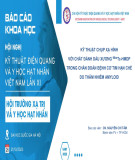
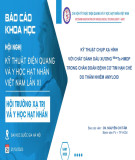

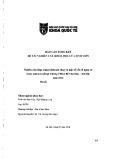

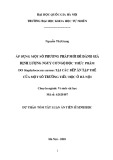
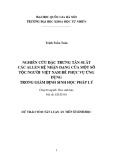







![Báo cáo seminar chuyên ngành Công nghệ hóa học và thực phẩm [Mới nhất]](https://cdn.tailieu.vn/images/document/thumbnail/2025/20250711/hienkelvinzoi@gmail.com/135x160/47051752458701.jpg)









